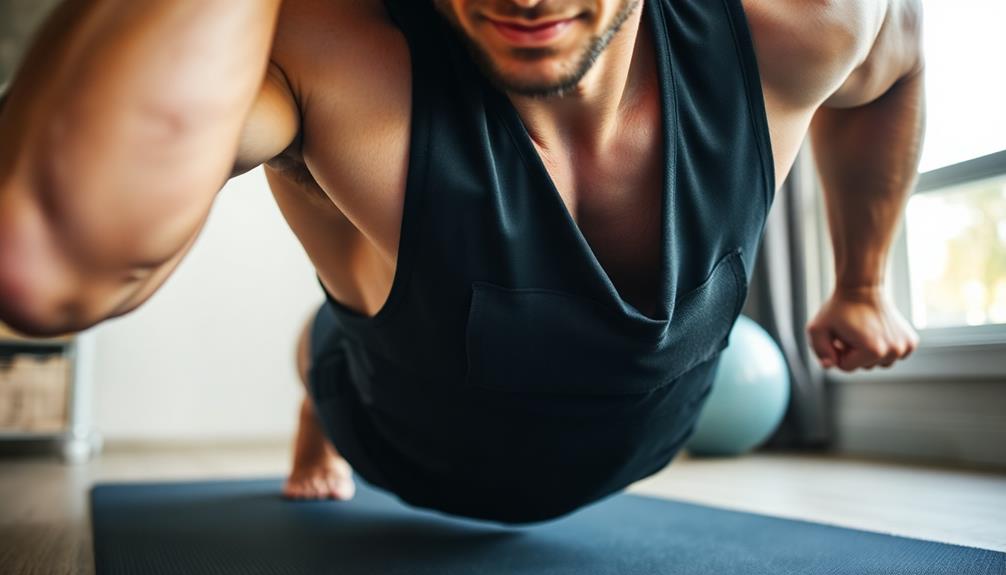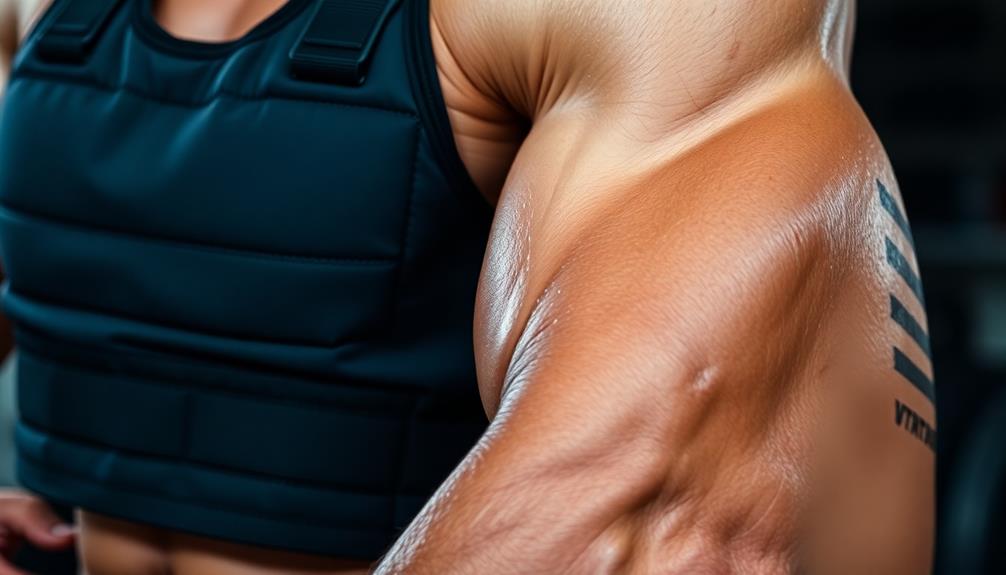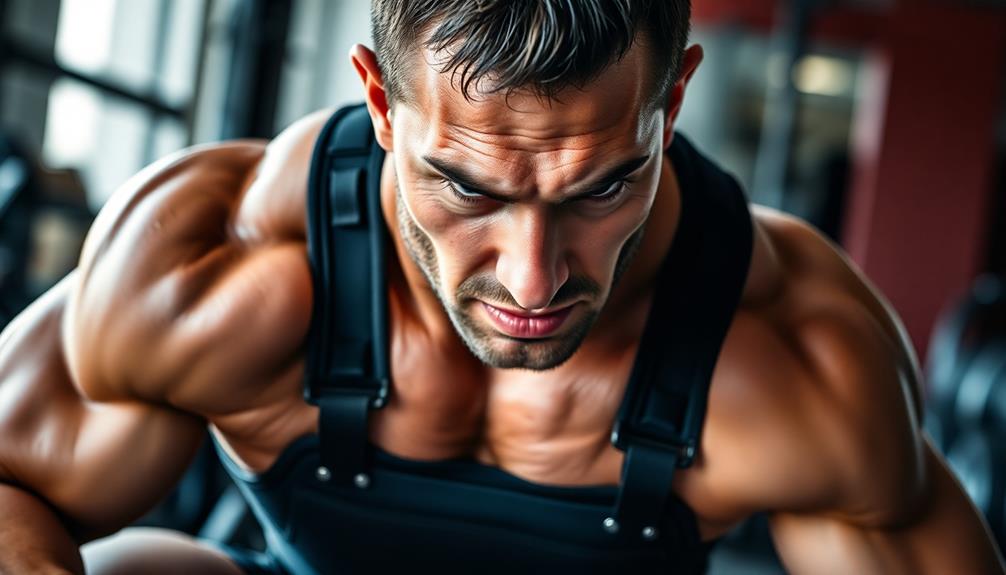Weighted vests build muscle through five key mechanisms. First, they increase resistance for bodyweight exercises, making them more challenging. Second, they facilitate progressive overload, allowing you to gradually increase weight over time. Third, they enhance muscle activation and engagement, requiring extra effort for stability and movement. Fourth, weighted vests elevate metabolic stress and hormone levels, promoting muscle growth. Finally, they improve balance and core strength by increasing muscle usage for stability. These benefits apply to various exercises, including push-ups, pull-ups, and squats. By incorporating weighted vests into your workouts, you'll experience significant gains in muscle strength and size. Let's explore each mechanism in more detail.
Core Insight
- Weighted vests increase resistance in bodyweight exercises, promoting muscle growth in various muscle groups.
- They enable progressive overload by allowing gradual weight increases, essential for continuous muscle development.
- Weighted vests enhance muscle activation and engagement, particularly in the core, legs, and back.
- They elevate metabolic stress and hormonal response, promoting growth hormone and testosterone release for muscle growth.
- Weighted vests improve balance and core strength, leading to better overall muscle development and functional fitness.
Increased Resistance for Bodyweight Exercises

Weighted vests are a great way to make bodyweight exercises harder. They work well for push-ups, pull-ups, and squats. The vests add weight evenly across your upper body. This extra weight makes your muscles work more. You can change the amount of weight to fit your fitness level and goals.
For push-ups, the added weight makes your chest, triceps, and shoulders work harder. Pull-ups also become more challenging with a vest. Your back and arm muscles have to lift more weight. Squats with a vest make your legs and core stronger. They help build muscle in your quads, hamstrings, and glutes.
Using a weighted vest lets you make exercises harder without changing how you do them. As you get used to the extra weight, you'll build muscle better than with just your body weight.
Progressive Overload Principle

Progressive overload is a key idea in strength training. It means slowly adding more weight over time to make your muscles work harder. Weighted vests make this easy. You can use them for all kinds of exercises, from body weight moves to cardio.
Start by picking a weight that challenges you but still lets you use good form. When the exercise starts to feel easier, add a little more weight to the vest. This pushes your muscles to keep getting stronger and bigger. As you keep adding weight, things that used to be hard will get easier.
Muscle Activation and Engagement

Weighted vests make your muscles work harder. When you wear one, your body has to put in extra effort to stay stable and move around. This means more of your muscle fibers get activated, especially in your core, legs, and back.
Weighted vests affect different muscles in different ways:
| Muscle Group | Effect of Weighted Vest |
|---|---|
| Core | Better stability |
| Legs | Stronger lower body |
| Back | Straighter posture |
| Arms | More resistance when pulling |
Metabolic Stress and Hormonal Response

Wearing a weighted vest during exercise can boost your body's metabolic stress and hormone levels. This stress triggers changes that help build muscle and strength. Adding extra weight to your workouts makes them more challenging, leading to:
- More growth hormone production
- Increased testosterone release
- Higher levels of IGF-1, a hormone that helps with muscle growth
These hormonal changes are key for building muscle and recovering after exercise. Weighted vest workouts also burn more energy, both while you're exercising and afterward. This means you'll keep burning calories at a higher rate even after your workout is over. To get the most out of weighted vest training, think about using ice baths as part of your post-workout recovery. By regularly using a weighted vest in your workouts, you'll create the right conditions for muscle growth and improving your overall body composition.
Improved Balance and Core Strength

Wearing a weighted vest can improve your balance and core strength. As you move with extra weight, your body uses more muscles to stay stable. This makes your core muscles, like your abs and lower back, stronger. You'll have better posture and a solid base for all your movements.
The extra weight also tests your body's ability to know where it is in space. As you exercise or do daily tasks with a weighted vest, your body has to get used to the new weight. This makes your overall balance and coordination better. You'll be more stable during workouts and everyday activities. This lowers your chance of falling and getting hurt while building a stronger, more useful body.
Frequently Asked Questions
How Heavy Should a Weighted Vest Be for Muscle Building?
You should start with a vest that's 5-10% of your body weight for muscle building. As you get stronger, gradually increase the weight. Don't exceed 20% of your body weight to avoid injury risks.
Can Weighted Vests Be Used During Cardio Exercises for Muscle Growth?
Yes, you can use weighted vests during cardio for muscle growth. They'll increase resistance, making your muscles work harder. You'll build strength and endurance, especially in your legs and core. Remember to start light and gradually increase weight.
Are Weighted Vests Safe for Individuals With Back Problems?
If you have back problems, you should be cautious with weighted vests. They can increase stress on your spine and exacerbate existing issues. It's best to consult your doctor or physical therapist before using one.
How Often Should Weighted Vests Be Worn for Optimal Muscle Gains?
You should wear weighted vests 2-3 times a week for peak muscle gains. Don't overdo it; allow your body to recover between sessions. Start with shorter durations and gradually increase as you build strength and endurance.
Can Weighted Vests Replace Traditional Weightlifting for Building Muscle Mass?
While weighted vests can complement your workout routine, they can't fully replace traditional weightlifting for building muscle mass. You'll likely see better results by combining both methods, as weightlifting offers more variety and progressive overload opportunities.

